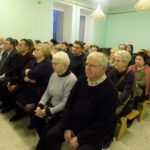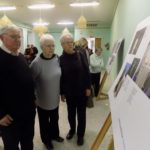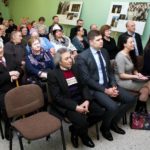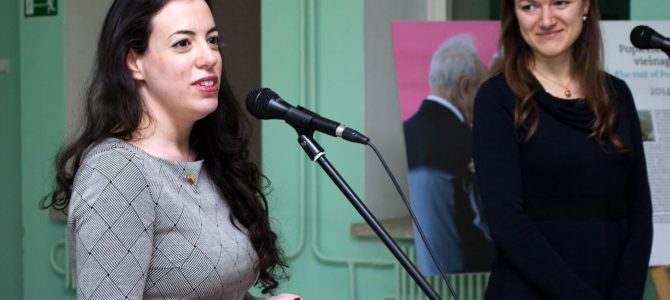
by Galina Romanova
On January 31 the cozy hall of the Nalšia Museum was packed to the gills for the ceremonial opening of an exhibit of interest to the whole world, and especially Catholics called “Pope Francis’s Visit to Israel.” Israeli embassy deputy chief of mission Efrat Hochstetler, Švenčionys regional administration head Rimantas Klipčius, regional administration council members, other public figures and locals from the town and region of Švenčionys attended the opening.
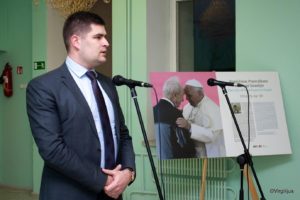
Israeli embassy press attaché Liana Jagniatinskytė recalled how the embassy came up with the idea of this exhibit and “released it into the wild,” sending the exhibit to small towns and larger cities throughout Lithuania.
Klipčius said he was glad friendship between Israel and the Švenčionys region keeps growing, thanking Israeli ambassador and frequent guest to the region Amir Maimon. The director of the regional administration spoke about the Pope’s trip to Israel and recalled Pope John Paul II’s visit to Lithuania just as the country broke free from the Soviet Union. He finished his optimistic speech with a nice gesture, presenting flowers and souvenirs to Hochstetler, who was in the region for the first time.
Švenčionys Jewish Community chairman Moshe Shapiro spoke about the Holocaust and reported that thanks to the regional administration and the director the project to commemorate all the Holocaust victims at the military base between Švenčionėliai and Šalnaitis lake had begun. He detailed the plan to place one small obelisk there for every person buried in the common grave, and asked the public for help in discovering all the names of those murdered. He thanks the staff of the Nalšia Museum for organizing the exhibition and singled out director Alytė Šekštelienė and historian Nadežda Spiridonovienė for special thanks.
Deputy chief of mission at the Israeli embassy Efrat Hochstetler continued in the same vein as the regional director, speaking about the importance of friendship between countries, and thanked organizers for the opportunity to visit Švenčionys. He concluded with a significant phrase: “There should be love, understanding and humanity between people.”
Nalšia Museum director Alytė Šekštelienė took joy in the opportunity to host such an important exhibit at her institution and presented organizers with DVDs published by the museum containing the Švenčionys folk song “Three Generations.” This song is listed on UNESCO’s World Cultural Heritage Registry. Šekštelienė thanked Klipčius personally for helping bring such significant exhibits to the museum, recently one about Croatia and now about Pope Francis’s visit to Israel. The museum director said she was sure a large number of people and pupils from the Švenčionys would visit and view the exhibit.
Israeli embassy staff thanked Švenčionys parish deacon Medardas Čeponys, who wasn’t able to attend due to illness, for his help in putting the exhibit on and sent their wishes he would recover soon.
The opening ceremony included a music program by teachers and students at the Julius Sinius Art School in Švenčionys. Two violin ensembles directed by the teacher Virginija Beržinskienė called Tupi žvirblis kamine [The Sparrow Sits upon the Branch] and Gama-džiazas [Gama-Jazz] performed emotionally moving pieces accompanied by concertmaster Marina Tkačenko. Stasys Montrimas, winds instrument music teacher, performed on saxophone accompanied by concertmaster pianist Ilona Vinikaitė.


